Confederate Brigadier General Felix Kirk Zollicoffer had been operating in eastern Kentucky near Cumberland Gap since September 1861. In an attempt to guard as much territory in southeastern Kentucky as possible, he moved to Mill Springs on the south bank of the Cumberland River in November 1861. He then crossed the river immediately opposite Mill Springs to Beech Grove and fortified his position. The only real threat to his position in November 1861 was a brigade of the Army of the Ohio under the command of brigadier General Albin Schoepf of Brigadier General George Henry Thomas’s 1st Division, fifteen miles away at Somerset, Kentucky.
In late November, Zollicoffer received an order from Major General George Bibb Crittenden in Knoxville, Tennessee, to withdraw back to the south bank of the Cumberland River. Concerned about the growing Federal presence in Kentucky, Crittenden went to the state in early January 1862. He arrived on 3 January 1862 to find Zollicoffer still at Beech Grove and a Federal force under George Thomas on the way. Zollicoffer had dug in fairly effectively with the Cumberland on his left flank and Fishing Creek on his right. The Cumberland was especially high, and it would have been difficult to move the approximately 4,000 men across if Beech Grove were attacked during the crossing. For that reason, Crittenden decided to stay there.
Thomas had departed from Lebanon, Kentucky, with part of his division on 1 January 1862. He made his way to Columbia, Kentucky, over almost impassible muddy roads. From Columbia he made it to Logan’s Cross Roads on 17 January. He made camp, waited for the remainder of his force to slog its way in on the muddy roads¸ and sent word to Schoepf to send him three regiments.
Thomas’s scouts almost immediately told him that Crittenden was preparing to move out of his earthworks at Beech Grove, only ten miles from Logan’s Cross Roads. As a result, Thomas began preparing for an attack. He planned to absorb the first blows of whatever Crittenden and Zollicofer planned and then counterattack after he determined their weaknesses. He hoped to have the rest of his men at Logan’s Cross Roads, Schoepf’s men from Somerset, and a brigade he called for from London, Kentucky¸ before the fighting began. He placed strong guards on the roads and sent out a large patrol to warn of any Confederate probed. On the night of 17 January, that patrol repelled a strong Confederate reconnaissance of his position.
During the day of 18 January, more of Thomas’s men arrived, along with word that the forces from Somerset and London were on the way. Thomas went to bed that night after sending out scouts to give plenty of warning of a Confederate march. Thomas was awakened at midnight with the news that the Confederates were on the move. He immediately dressed and conferred with his officers regarding the disposition of the troops.
The Confederate march was slowed by a steady rain and poor roads. As a result, Thomas had time to receive full scouting reports about the strength and arrangements of the Southern force. He knew that two Confederate brigades under Zollicoffer and Brigadier General William Carroll, led by two cavalry companies and flanked on either side by a cavalry battalion, were moving toward his position and that they would be supported by two artillery batteries.
[amazon_enhanced asin=”096485502X” /]
The two lead Confederate cavalry companies first made contact with Thomas’s cavalry at about 5:30 a.m. The Federal cavalry fell back to Colonel Mahlon Dickerson Manson’s brigade. Manson’s defensive line was attacked by Zollicoffer’s brigade. Zollicoffer spread his men out to the right of the road and tried to maneuver his men around the Union left flank. Just as it appeared that he might succeed, the troops from London, Kentucky, under Colonel Samuel Powhatan Carter, arrived. Thomas was able to place them on his left, and the flank held.
The Confederates next attacked in force against the center of Thomas’s line. Unfortunately for the Union forces there, the attack came when many of them were low on ammunition. In a quick maneuver, Thomas moved up two fresh regiments, allowing those in front to go for ammunition.
While the Confederates pressed the attack on the center, Thomas was able to swing Carter’s brigade slightly to the right to enfilade the attacking Confederates. During the confusion this maneuver caused, Thomas ordered his left to advance in a counterattack. About that time, Zollicoffer became confused and mistook one of the moving Federal regiments for one of his own. He approached the commander of the Union 4th Kentucky, Colonel Speed Smith Fry, and told him to quit firing. When one of Zollicoffer’s officers realized that Fry was a Union officer, the Confederate fired. Fry fired back, and either intentionally or because the Confederate general was in the way, struck and killed Zollicoffer.
About that time, the Union center, taking advantage of the gains made by the left, pressed forward. The effect was infectious all along the Confederate lines, as first the front ranks, followed by the others, fell back and began moving in a rout back to their defenses at Beech Grove.
Thomas had his men regroup and resupply, and then moved in pursuit. However, because of the condition of the roads, they did not arrive until early evening. All Thomas could do, without having a better view of the Confederate defenses in daylight, was to bombard the Confederate positions with his artillery.
During the night, Crittenden decided to retreat by ferrying his men across the Cumberland. He was able to do so but had to leave most of his artillery, horses, and supplies behind. Crittenden led his men to Mill Spring and then marched southeast to Cumberland Gap. Crittenden had suffered about 400 casualties and Thomas 246. Crittenden was severely criticized for his conduct of the campaign, and, after being censured, he resigned in the fall of 1862.
- David S. Heidler and Jeanne T. Heidler
[Source: Heidler, David S. and Jeanne T. Heidler. Encyclopedia of the American Civil War: A Political, Social and Military History. W.W. Norton & Co. 2002. pp. 1205-1207]
For further reading:
Cleaves, Freeman. Rock of Chickamauga, the Life of General George T. Thomas.
Hafendorfer, Kenneth A. Mill Springs: Campaign and battle of Mill Springs, Kentucky.
McKinney, Francis F. Education in Violence: The Life of George H. Thomas and the History of the Army of the Cumberland.
[From the Official Records of the War of the Rebellion, Series 1, Vol. 7]
CAPTURED FLAGS
HEADQUARTERS 1ST DIVISION
DEPARTMENT OF THE OHIO
SOMERSET, KY., February 3rd, 1862
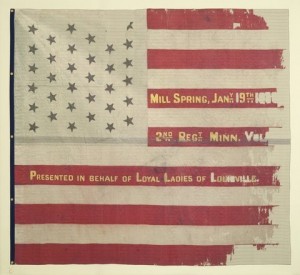
Battle Flag of the 2nd Minnesota Volunteer Infantry - part of the Civil War Battle Flags conservation project, Minnesota Historical Society
BRIG. GENL. D. C. BUELL,
Commanding Department of the Ohio, Louisville, Ky.
GENERAL: - I have the honor to forward to you by Captain Davidson, 10th Kentucky volunteers, six Rebel flags: one captured on the battle field by the 2nd Minnesota regiment, the others taken in the intrenchments by officers and men of the other regiments. Col. Kise reports that his men captured three stands of colors, but none have been sent to these headquarters. I have ordered him to turn them in, and will forward them as soon as received. In the box with the colors is a regimental order book of the 15th Mississippi rifles, and a book of copies of all Gen. Zollicoffer’s orders from the organization of the brigade until a few days before the battle. I am, General, very respectfully,
Your obedient servant,
GEO. H. THOMAS
Brigadier General, U.S. Volunteers, commanding.
Report of Col. H.P. Van Cleve, 2nd Minnesota Infantry commander
HEADQUARTERS 2ND REGIMENT
MINNESOTA VOLUNTEERS
CAMP HAMILTON, KY., January 22, 1862.
SIR: - I have the honor herewith to submit my report of the part taken by the 2nd Minnesota regiment in the action of the Cumberland on the 19th inst:
About seven o’clock on the morning of that day, and before breakfast I was informed by Col. Manson, of the 10th Indiana commanding the 2nd brigade of our division, that the enemy was advancing in force and that he was holding them in check, and that it was the order of Gen. Thomas that I should form my regiment and march immediately to the scene of action. Within ten minutes we had left our camp and were marching toward the enemy. Arriving at Logan’s field, by your order, we halted in line of battle, supporting Standart’s battery, which was returning the fire of the enemy’s guns, whose balls and shells were falling near us. As soon as the 9th Ohio came up and had taken its position on our right we continued our march, and after proceeding about half a mile we came upon the enemy, who were posted behind a fence along the road, beyond which there was an open field broken by ravines. The enemy, opening upon us, a galling fire fought desperately, and a hand-to-hand fight ensued, which lasted about thirty minutes.
The enemy having met with so warm a reception in front, and also having been flanked on their left by the 9th Ohio, and on their right by a portion of our left, who, by their well directed fire drove them from behind their hiding places, gave way, leaving a large number of their dead and wounded on the field. We joined in the pursuit which continued till near sunset, when we arrived within a mile of their intrenchments, where we rested on our arms during the night. The next morning we marched into their works which we found deserted. The enemy had crossed the Cumberland.
Six hundred of my regiment were in the engagement, twelve of whom were killed and thirty-three wounded.
I am well satisfied with the conduct of my entire command during the severe and close engagement in which they took part. Where all behaved so well I have no desire to make individual distinction.
Very respectfully, your obedient servant,
H.P. VAN CLEVE,
Colonel commanding 2nd Minnesota Volunteers
Report of Col. Robert L. McCook, Commanding Brigade.
HEADQUARTERS 3RD BRIGADE, 1ST DIVISION
DEPARTMENT OF THE OHIO
SOMERSET, January 27th, 1862.
SIR: - I have the honor respectfully to submit the following report of the part which my Brigade took in the battle of the Cumberland, on the 19th inst.
Shortly after seven A.M., Col. Manson informed me that the enemy had driven in his pickets and were approaching in force. That portion of the brigade with me, the 9th Ohio and the 2nd Minnesota Regiments, were formed and marched to a point near the junction of the Mill Springs and Cumberland roads, and immediately in the rear of Wetmore’s battery, the 9th Ohio on the right and the 2nd Minnesota on the left of the Mill Springs road. From this point I ordered a company of the 9th Ohio to skirmish the woods on the right to prevent any flank movement of the enemy. Shortly after this, Col. Manson, commanding the 2nd brigade, informed me in person that the enemy were in force and in position on the top of the next hill beyond the woods, and that they forced him to retire. I ordered my brigade forward through the woods in line of battle skirting the Mill Springs road. The march of the 2nd Minnesota was soon obstructed by the 10th Indiana, which was soon obstructed by the 10th Indiana, which was scattered through the woods waiting for ammunition. In front of them I saw the 4th Kentucky engaging the enemy, but evidently retiring. At this moment the enemy with shouts advanced on them about 100 yards and took position within the field on the hilltop near the second fence from the woods. At this time I received your order to advance as rapidly as possible to the hilltop. I ordered the 2nd Minnesota Regiment to move by the flank until it passed the 10th Indiana and 4th Kentucky and then deploy to the left of the road. I ordered the 9th Ohio to move through the first corn field to the right of the road and take position at the farther fence, selecting the best cover possible. The position of the 2nd Minnesota Regiment covered the ground formerly occupied by the 4th Kentucky and 10th Indiana, which brought their right flank within about ten feet of the enemy where he had advanced upon the 4th Kentucky. The 9th Ohio position checked an attempt on the part of the enemy to flank the position taken by the 2nd Minnesota and consequently brought the left wing almost against the enemy, where he was stationed behind straw stacks and piles of fence rails. Another regiment was stationed immediately in front of the 9th Ohio, well covered by a fence and some woods, a small field not more than sixty yards wide, intervening between the positions. The enemy also had possession of a small log house, stable and corn-crib, about fifty yards in front of the 9th Ohio.
Along the lines of each of the regiments, and from the enemy’s front a hot and deadly fire opened. On the right wing of the 2nd Minnesota regiment the contest was at first almost hand-to-hand; the enemy and the 2nd Minnesota were poking their guns through the same fence. However, before the fight continued long in this way, that part of the enemy contending with the 2nd Minnesota regiment, retired in good order to some rail piles hastily thrown together, the point from which they had advanced upon the 4th Kentucky. This portion of the enemy obstinately maintaining their position and the balance remaining as before described, a desperate fire was continued for about thirty minutes, with seemingly doubtful results. The importance of possessing the log house, stable and corn-crib soon became apparent and companies A, B, C and D, of the 9th Ohio were ordered to flank the enemy upon the extreme left and obtain possession of the house. This done, still the enemy stood firm to his position and cover. During this time the artillery of the enemy constantly overshot my brigade. Seeing the superior number of the enemy and their bravery, I concluded the best mode of settling the contest was to order the 9th Ohio regiment to charge the enemy’s position with the bayonet and turn his left flank. The order was given the regiment to empty their guns and fix bayonets; this done, it was ordered to charge. Every man sprang to it with alacrity and vociferous cheering, the enemy seemingly prepared to resist it, but before the regiment reached him the lines began to give way. But few of them stood, possibly ten or twelve.
This broke the enemy’s flank and the whole line gave way in great confusion, and the whole turned into a perfect rout. As soon as I could form the regiments of my brigade I pursued the enemy to the hospital, where you joined the advance. I then moved my command forward under orders in line of battle to the foot of Moulden’s Hill, passing on the way one abandoned cannon.
The next morning we marched into the deserted works of the enemy, and on the following day returned to our camp. At the time of the first advance of the 9th Ohio, I was shot through the right leg below the knee. Three other balls passed through my horse and another through my overcoat. After this I was compelled to go on foot till I got to the hospital of the enemy. About the time I was shot in the leg aid-de-camp Andrew S. Burt was shot in the side.
Too much praise cannot be awarded to the company officers, non-commissioned officers and the soldiers of the two regiments. Notwithstanding they had been called out before breakfast and had not tasted food all day, they conducted themselves throughout like veterans, obeying each command and executing every movement as though they were on parade. Although all the officers of the command evinced the greatest courage and deported themselves under fire in a proper soldierly manner, were I to fail to specify some of them, it would be great injustice. Lieut. Andrew S. Burt, aid-de-camp of the 18th U.S. infantry; Hunter Brooke, private of the 2nd Minnesota regiment and volunteer aid-de-camp, Maj. Gustave Kammerling commanding the 9th Ohio; Capt. Charles Joseph, Co. A; Capt. Frederick Shroder, Col. D; Geo. H. Harries, adjutant, of the 9th Ohio regiment; Col. H.P. Van Cleve, James George, Lieut. Col. Alex. Wilkin, Major of the 2nd Minnesota, each displayed great valor and judgment in the discharge of their respective duties, so much so, in my judgment, as to place the country and every honest friend thereof under obligations to them.
In conclusion, permit me, sir, to congratulate you upon the victory achieved and allow me to express the hope that your future efforts will be crowned with the same success.
Attached you will find the number of the force of my brigade engaged, and also a list of the killed and wounded.
I am respectfully yours,
ROB’T L. MCCOOK
Col. 9th Ohio Regiment
Commanding 3rd Brigade, 1st Division, Dept. of the Ohio
Brig. Gen. Geo. H. Thomas, commanding 1st Division.
Report of Gen. George H. Thomas, commanding division.
HEADQUARTERS 1ST DIVISION
DEPARTMENT OF THE OHIO.
SOMERSET, KY., January 31st, 1862.
CAPTAIN: - I have the honor to report that in carrying out the instructions of the general commanding the department, contained in his communication of the 29th of December, I reached Logan’s cross roads, about ten miles north of the entrenched camp of the enemy on the Cumberland river, on the 17th inst., with a portion of the 2nd and 3rd brigades, Kenny’s battery of artillery, and a battalion of Wolford’s cavalry.
* * * * * * * * * * * * *
About 6:30 o’clock on the morning of the 19th the pickets from Wolford’s cavalry encountered the enemy advancing on our camp, retired slowly and reported their advance to Col. M. D. Manson, commanding the 2nd brigade. He immediately formed his regiment, the 10th Indiana, and took a position on the road to await the attack, ordering the 4th Kentucky (Col. S. S. Fry) to support him, and then informed me in person that the enemy were advancing in force, and what disposition he had made to resist him. I directed him to join the brigade immediately and hold the enemy in check until I could order up the other troops, which were ordered to form immediately and were marching towards the field in ten minutes afterwards. The battalion of Michigan engineers and Company “A,” 38th Ohio (Capt. Greenwood), were ordered to remain as guards to the camp.
Upon my arrival on the field soon afterwards I found the 10th Indiana formed in front of their encampment, apparently awaiting orders, and ordered them forward to the support of the 4th Kentucky, which was the only entire regiment then engaged. I then rode forward myself to see the enemy’s position, so that I could determine what disposition to make of my troops as they arrived. On reaching the position held by the 4th Kentucky, 10th Indiana and Wolford’s cavalry, at a point where the roads fork leading to Somerset, I found the enemy advancing through a cornfield and evidently endeavoring to gain the left of the 4th Kentucky regiment, which was maintaining its position in a most determined manner. I directed one of my aides to ride back and order up a section of artillery and the Tennessee brigade to advance upon the enemy’s right in a most determined manner. I directed one of my aides to ride back and order up a section of artillery and the Tennessee brigade to advance upon the enemy’s right, and sent orders for Col. McCook to advance with his two regiments, 9th Ohio and 2nd Minnesota, to support the 4th Kentucky and 10th Indiana.
A section of Capt. Kenny’s battery took position on the edge of the field to the left of the 4th Kentucky, and opened an efficient fire on a regiment of Alabamians which were advancing on the 4th Kentucky. Soon afterwards the 2nd Minnesota (Col. H.P. Van Cleve) arrived, the Colonel reporting to me for instructions. I directed him to take the position of the 4th Kentucky and 10th Indiana, which regiments were nearly out of ammunition. The 9th Ohio, under the immediate command of Maj. Kammerling, came into position on the right of the road at the same time.
Immediately after these regiments had gained their positions the enemy opened a most determined and galling fire, which was returned by our troops in the same spirit, and for nearly half an hour the contest was maintained on both sides in the most obstinate manner. At this time the 12th Kentucky (Col. W. A. Hoskins) and the Tennessee brigade reached the field, to the left of the Minnesota regiment, and opened fire on the right flank of the enemy, who then began to fall back. The 2nd Minnesota kept up a most galling fire in front and the 9th Ohio charged the enemy on the right with bayonets fixed, turned their flank and drove them from the field, the whole line giving away and retreating in the utmost disorder and confusion. As soon as the regiments could be formed and refill their cartridge boxes, I ordered the whole force to advance. A few miles in the rear of the battlefield a small force of cavalry was drawn up near the road, but a few shots from our artillery (a section of Standart’s battery) dispersed them, and none of the enemy were seen again until we arrived in front of their intrenchments. As we approached their intrenchments the division was deployed in line of battle and steadily advanced to the summit of the hill at Moulden’s. From this point I directed their intrenchments to be cannonaded, which was done until dark by Standart’s and Wetmore’s batteries. Kenny’s battery was placed in position on the extreme left, near Russell’s house, from which point he was directed to fire on their ferry, to deter them from attempting to cross. On the following morning Capt. Wetmore’s battery was ordered to Russell’s house, and assisted with his Parrot guns in firing upon the ferry. Col. Manson’s brigade took position on the left, near Kenny’s battery, and every preparation was made to assault their intrenchments on the following morning. The 14th Ohio (Colonel Steedman) and the 10th Kentucky (Colonel Harlan) having joined from detached service soon after the repulse of the enemy, continued with their brigade in the pursuit, although they could not get up in time to join in the fight. These two regiments were placed in front in my advance on the intrenchment the next morning, and entered first. General Schoepf also joined me the evening of the 19th with the 17th, 31st and 38th Ohio. His entire brigade entered with the other troops.
On reaching the intrenchments we found that the enemy had abandoned everything and retired during the night. Twelve pieces of artillery with their caissons packed with ammunition, one battery wagon and two forges, a large amount of ammunition, a large number of small arms, mostly the old flint-lock muskets; 150 or 160 wagons, and upwards of 1,000 horses and mules; a large amount of commissary stores, intrenching tools and camp and garrison equipage, fell into our hands. A correct list of all the captured property will be forwarded as soon as it can be made up and the property secured.
The steam and ferry boats having been burned by the enemy in their retreat, it was found impossible to cross the river and pursue them; besides, their command was completely demoralized, and retreated in great haste and in all directions, making the capture in any numbers quite doubtful if pursued. There is no doubt but what the moral effect produced by their complete dispersion will have a more decided effect in re-establishing Union sentiments than though they had been captured. It affords me much pleasure to be able to testify to the uniform steadiness and good conduct of both officers and men during the battle, and I respectfully refer to the accompanying reports of the different commanders for the names of those officers and men whose good conduct was particularly noticed by them.
I regret to have to report that Col. R. L. McCook, commanding the 3rd brigade, and his aide, A.S. Burt, 18th U.S. Infantry, were both severely wounded in the first advance of the 9th Ohio regiment, but continued on duty until the brigade returned to camp at Logan’s cross roads.
Col. S. S. Fry, 4th Kentucky, was slightly wounded, whilst his regiment was gallantly resisting the advance of the enemy, during which time Gen. Zollicoffer fell from a shot from his (Col. Fry’s) pistol, which no doubt contributed materially to the discomfiture of the enemy.
* * * * * * * * * * * *
The enemy’s loss as far as known is as follows: Brigadier General Zollicoffer, Lieut. Bailie Peyton and 190 officers, non-commissioned officers and privates killed; Lieut. Col. M. B. Carter, Twentieth Tennessee; Lieut. J. W. Allen, Fifteenth Mississippi; Lieut. Allen Morse, Sixteenth Alabama, and five officers of the medical staff and 81 non-commissioned officers and privates taken prisoners; Lieut. J. E. Patterson, Twentieth Tennessee, and A. J. Knapp, Fifteenth Mississippi, and 66 non-commissioned officers and privates, wounded, making 192 killed, 89 prisoners not wounded and 68 wounded; total of killed, wounded and prisoners, 349.
(NOTE – Crittenden reports 408 wounded and missing, which with the 192 dead, buried by Thomas, makes the enemy’s loss 600.)
Our loss as follows:
10th Indiana – 10 men killed; 3 officers and 72 men wounded.
1st Kentucky, Cavalry – 1 officer and 2 men killed; 19 men wounded.
4th Kentucky – 8 men killed; 4 officers and 48 men wounded.
2nd Minnesota – 12 men killed; 2 officers and 31 men wounded.
9th Ohio – 6 men killed; 4 officers and 24 men wounded.
Total – 1 officer and 38 men killed; 13 officers and 194 men wounded.
A complete list of the names of our killed and wounded and of the prisoners is herewith attached.
I am, sir, very respectfully, your obedient servant,
GEO. H. THOMAS,
Brigadier General U. S. Volunteers Commanding.
Capt. J. B. FRY, A. A. G.
Chief of Staff, Headquarters, Dept. of Ohio, Louisville, Ky.
Additional links:
Mill Springs Battlefield Association
Mill Springs 150th Anniversary Reenactment Jan. 21-22, 2012
Civil War Trust’s Mill Springs Resources
10 Facts about Mill Springs
Mill Springs National Cemetery
For information on the Civil War Trust’s effort to save 16 acres of the Mill Springs battlefield, click here.

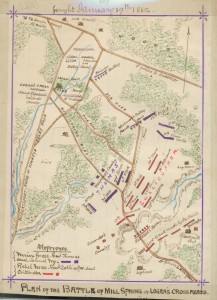
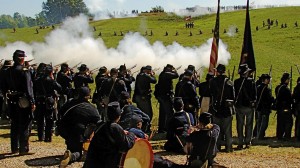
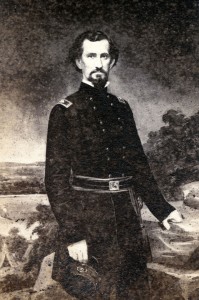
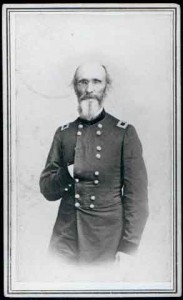
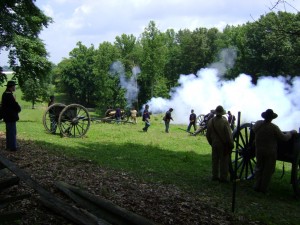
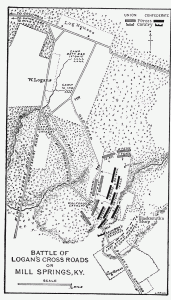
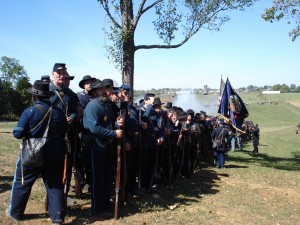
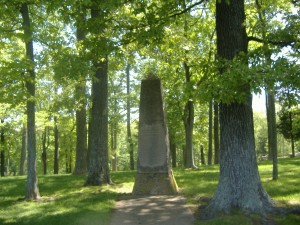
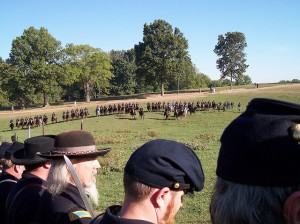

Pingback: Brigadier General Felix Kirk Zollicoffer (1812-1862) C.S.A. | This Week in the Civil War
Pingback: Minnesotans faced first Civil War combat action at Mill Springs 150 years ago | This Week in the Civil War
Pingback: Homepage